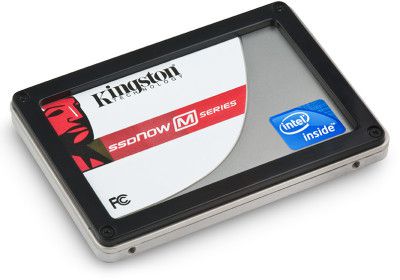From our front-page news:
SSDs might have been out and about for a couple of years, but up until now, I've never used one in my personal machine. I've of course fiddled with them on our benchmarking machines, but as for putting one to a more realistic, and long-term use, I haven't. That's going to soon change, though, as I have picked up one of Kingston's latest 80GB drives, based on Intel's X25-M G2. That means that this drive supports TRIM, and that's pretty much exactly what I was waiting for before committing to an SSD.
Under the hood, Kingston's G2 drives are a spitting image of Intel's own, except for the sticker. So, like Intel's G2 80GB, this drive features a 250MB/s read speed, and also a 70MB/s write speed. The write speed is lacking, it goes without saying, but as I have mentioned many times before, Intel's SSDs excel where random reads and writes are concerned, making it a no-brainer choice for those who aren't entirely concerned with sequential write speeds.
Installing the G2 drive, or any other that supports TRIM, in Windows is rather simple. As long as you're running Windows 7, TRIM will work if the SSD
supports it. For previous Windows OS', a tool needs to be run on occasion to get the job done. It's a less elegant solution, but at least there's an option at all. For me, I have a challenge ahead. As many of you I'm sure are aware, I don't run Windows as my primary OS, but rather Linux (Gentoo to be specific). So the next few months should prove interesting.
The situation of TRIM on Linux is difficult to understand right now. Officially, TRIM support was added to the Linux kernel last fall (2.6.28), but how it's activated, or compiled in, I'm not sure. There's also the question of whether TRIM in Linux is filesystem-specific. So far, the only trace I see of TRIM support is usually linked to ext4, but once again, I am not sure if it's built in natively, or requires additional steps.

I've been asking around, and getting an answer to that has proven rather difficult. I plan to continue follow-up with various developers and companies to get a final answer, but unlike Windows 7, where the TRIM support is clear-cut, it's not so much in Linux. Part of this could be the fact that TRIM is called something different wherever you look, so it's likely easy to overlook it, even if you are staring right at it.
I'm hoping to learn a lot more in the coming weeks, especially before I install the drive. I have no real reason for holding off, except time, so I'm willing to wait to understand the situation better, so I know how to build the rig back up. Of course, if anyone out there in the Interwebs knows anything more of the TRIM situation in Linux, please comment in our thread and let me know. I should also stress that on a new SSD, especially Intel's, TRIM isn't that important. This is more of a major curiosity of mine, and since I'm such a performance hound, having TRIM functionality is definitely an interest.
Under the hood, Kingston's G2 drives are a spitting image of Intel's own, except for the sticker. So, like Intel's G2 80GB, this drive features a 250MB/s read speed, and also a 70MB/s write speed. The write speed is lacking, it goes without saying, but as I have mentioned many times before, Intel's SSDs excel where random reads and writes are concerned, making it a no-brainer choice for those who aren't entirely concerned with sequential write speeds.
Installing the G2 drive, or any other that supports TRIM, in Windows is rather simple. As long as you're running Windows 7, TRIM will work if the SSD
supports it. For previous Windows OS', a tool needs to be run on occasion to get the job done. It's a less elegant solution, but at least there's an option at all. For me, I have a challenge ahead. As many of you I'm sure are aware, I don't run Windows as my primary OS, but rather Linux (Gentoo to be specific). So the next few months should prove interesting.
The situation of TRIM on Linux is difficult to understand right now. Officially, TRIM support was added to the Linux kernel last fall (2.6.28), but how it's activated, or compiled in, I'm not sure. There's also the question of whether TRIM in Linux is filesystem-specific. So far, the only trace I see of TRIM support is usually linked to ext4, but once again, I am not sure if it's built in natively, or requires additional steps.

I've been asking around, and getting an answer to that has proven rather difficult. I plan to continue follow-up with various developers and companies to get a final answer, but unlike Windows 7, where the TRIM support is clear-cut, it's not so much in Linux. Part of this could be the fact that TRIM is called something different wherever you look, so it's likely easy to overlook it, even if you are staring right at it.
I'm hoping to learn a lot more in the coming weeks, especially before I install the drive. I have no real reason for holding off, except time, so I'm willing to wait to understand the situation better, so I know how to build the rig back up. Of course, if anyone out there in the Interwebs knows anything more of the TRIM situation in Linux, please comment in our thread and let me know. I should also stress that on a new SSD, especially Intel's, TRIM isn't that important. This is more of a major curiosity of mine, and since I'm such a performance hound, having TRIM functionality is definitely an interest.
